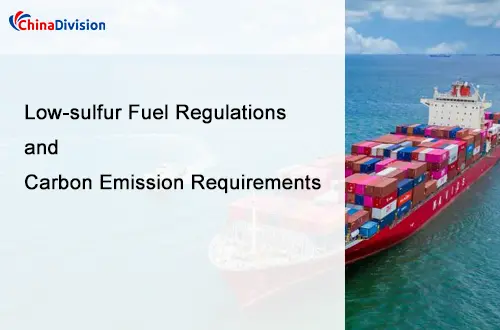Low-sulfur Fuel Regulations and Carbon Emission Requirements
For B2B manufacturing companies, trading companies and cross-border e-commerce sellers, low-sulfur fuel regulations and carbon emission control requirements are no longer distant environmental issues, but core factors that profoundly affect cost structure, operational efficiency and market competitiveness.
Table of Contents
Since the International Maritime Organization (IMO) implemented the global marine fuel sulfur content limit (sulfur content ≤ 0.5% m/m) in 2020, more than 85% of commercial ships in the world have completed compliance transformation. The amendment to Annex VI of the MARPOL Convention adopted by IMO in April 2025 has incorporated carbon emission control into the mandatory framework, requiring greenhouse gas fuel intensity (GFI) graded supervision for ships over 5,000 gross tons from 2027. This trend not only concerns shipping companies, but also directly affects the supply chain costs and compliance risks of B2B companies and e-commerce sellers that rely on shipping.
In this article, we will take a closer look at these regulations and explain how they affect your business, helping you stay compliant, reduce emissions and build a greener supply chain.

What are low-sulfur fuel regulations?
Core requirements of the global sulfur limit
Sulfur content limit: From 2020, international ships must use fuel with a sulfur content of ≤0.5% m/m in global waters. In certain emission control areas (ECAs), such as North America, Europe, and the Mediterranean, the sulfur content limit is stricter, only 0.10%. . It aims to reduce sulfur oxide emissions from ships and improve air quality.
Penalties for violations: The China Maritime Safety Administration imposes fines of 10,000 to 100,000 yuan on non-compliant ships, and requires them to unload non-compliant fuel or submit a "non-use in Chinese waters" commitment.
Alternative measures: Ships can achieve compliance by installing exhaust gas cleaning systems (EGCS) or using alternative fuels such as LNG and methanol.
Economics and challenges of alternative fuels
LNG fuel: Currently, more than 1,000 LNG-powered ships are in operation around the world, but LNG is still a fossil fuel and can only meet the basic emission reduction targets before 2035.
Green methanol and ammonia fuel: The technology is less mature, but the emission reduction effect is significant. For example, Maersk has ordered 25 methanol-powered container ships, which are scheduled to be put into operation from 2024.
Cost comparison: The cost of LNG fuel is about 20%-30% higher than that of traditional fuel, while the cost of green methanol may be 3-5 times higher.
Impact on enterprises
Cost surge: VLSFO prices are significantly higher than traditional high-sulfur fuel oil (HSFO), which directly pushes up shipping rates. Shipping companies generally pass on costs by levying low-sulfur fuel surcharges (LSS), which have become an important part of the freight structure.
Supply chain fluctuations: The increased volatility of fuel costs has led to increased uncertainty in freight and surcharges, affecting corporate budgets and pricing strategies.
Compliance risks: The use of non-compliant ships or fuels may lead to cargo delays, fines and even reputational damage.
Environmental advantages of low-sulfur fuel
Reduce air pollution: Reduce sulfur oxide (SOx) emissions, reduce acid rain and air pollution.
Improve health: Reduce respiratory diseases, especially for residents in ports and coastal areas.
In line with global environmental protection trends: Governments and companies are paying more and more attention to carbon emission reduction, and green logistics has become a competitive advantage.
What is a carbon emission control system?
The International Maritime Organization (IMO) adopted the "2023 IMO Ship Greenhouse Gas Emission Reduction Strategy" in 2023, proposing a goal of achieving net zero greenhouse gas emissions from international shipping by 2050. In addition, IMO has set phased emission reduction targets for 2030 and 2040, requiring the total annual greenhouse gas emissions from international shipping to be reduced by at least 20% and 70% respectively compared with 2008.
Existing Ship Energy Efficiency Index (EEXI) and Carbon Intensity Index (CII)
EEXI: Calculates theoretical carbon emission intensity based on ship design parameters (such as main engine power and deadweight tonnage). Old ships can meet the standards by reducing speed and installing energy-saving devices.
CII: Measures the actual operating efficiency of ships and is rated on an A-E scale. The rating results must be recorded in the Ship Energy Efficiency Management Plan (SEEMP). Ships with poor ratings (D or E grade) must develop rectification plans, and continued poor performance will face stricter supervision or even restrictions on operations.
Impact on enterprises
In order to improve their ratings, shipowners may take measures such as slowing down, which will extend the shipping time and lengthen the supply chain cycle.
New regulations in 2025: GFI tiered supervision and net zero fund
Two-level goals:
Direct compliance target: 43% reduction in emissions by 2035 compared with 2008, and those who meet the target can obtain "surplus units" (SU) for trading or storage.
Basic target: 30% reduction in emissions by 2035, those who fail to meet the target must purchase remedial units (RU) at US$100/ton, and the excess can be purchased at US$380/ton RU or historical SU.
Purpose of the net zero fund: reward low-carbon ships, support the transformation of developing countries, and compensate vulnerable countries.
Green shipping solutions
Use alternative fuels: such as liquefied natural gas (LNG), biofuels, and ammonia fuels to reduce carbon emissions.
Optimize routes: Smart route planning reduces fuel consumption and improves transportation efficiency.
Adopt energy-saving technologies: New technologies such as wind-assisted propulsion and battery-powered ships are being promoted.
What are the corporate response strategies?
- Fuel selection
Short-term strategy: Use low-sulfur fuel oil or install exhaust gas cleaning systems to meet sulfur content requirements.
Long-term strategy: Evaluate the feasibility of low-carbon or zero-carbon fuels, such as LNG, methanol, etc., and gradually replace traditional fuel oil.
- Technology upgrade
Ship modification: Consider installing scrubbers or power system modifications to improve energy efficiency and reduce carbon emissions.
Energy efficiency management: Use advanced energy efficiency management software to optimize speed and routes and reduce operating costs.
- Compliance management
Real-time monitoring: Use intelligent systems to monitor the carbon emissions and energy efficiency indicators of ships in real time to ensure compliance with regulatory requirements.
Carbon credit trading: Participate in carbon credit trading and balance carbon emissions by buying or selling carbon credits.
In-depth issues and solutions for B2B companies and e-commerce sellers
How to pass on the increase in compliance costs?
The use of low-sulfur fuel oil and alternative fuels will lead to higher transportation costs and may compress profit margins.
Solution
Optimize the supply chain: Through Chinadivision's intelligent logistics system, dynamically match low-sulfur fuel routes and ships to reduce unit transportation costs.
Carbon cost sharing: Introduce "green premium" in product pricing and deliver environmental protection value to consumers through e-commerce platforms.
How to ensure full compliance of the supply chain?
Suppliers may use non-compliant fuel due to cost pressure, resulting in cargo detention or fines.
Solution:
Supplier audit: Chinadivision provides supplier carbon footprint verification services to ensure that fuel procurement complies with IMO standards.
Digital tracking: Use blockchain technology to record fuel filling and ship navigation data to generate traceable compliance reports.
How to deal with carbon emission rating risks?
If the CII rating of the cooperating shipping company is too low, it may lead to delayed cargo delivery or contract breach.
Solution:
Fleet screening: Chinadivision establishes long-term cooperation with shipping companies rated A-B, giving priority to high-rated ship space.
Carbon credit trading: Assist enterprises to purchase SU or RU to hedge the risk of excessive carbon emissions.
Chinadivision's Green Logistics Solution
Cost Transparency and Optimized Management
We provide clear and structured cost split reports, detailing basic freight, LSS, expected/actual carbon emission surcharges and other related costs. Leverage scale advantages and bargaining power, as well as diversified carrier partnerships, to strive for the best freight rates and surcharge solutions for you. Provide cost forecasting tools through digital platforms to help you accurately calculate and price.
Timeliness guarantee and supply chain resilience improvement
Through intelligent route planning, give priority to shipping companies with high operating efficiency (good CII rating) and optimized routes to minimize the impact of speed reduction. Integrate multimodal transport solutions by sea, land, air and rail, and flexibly switch transportation modes at key nodes to ensure timeliness. Provide reliable timeliness prediction and active abnormal warning based on data analysis.
Compliance guarantee and risk management
We strictly screen compliant carriers and fleet partners to ensure that they meet IMO and EU regulations. Provide ship compliance verification services to reduce the risk of your goods being blocked due to non-compliance by shipowners. Establish a complete emergency response mechanism to quickly respond to regulatory changes or sudden compliance events.
Carbon emission visualization management and green reporting
Using advanced carbon calculation tools, based on international standards such as GLEC, we provide you with detailed carbon emission reports at the cargo transportation level. Support you to meet ESG reporting requirements or show the carbon footprint of products to end consumers. Explore low-carbon/zero-carbon fuel options (such as biofuel blending B30) and carbon offset solutions.
Strategic consulting and supply chain reshaping
Provide customized supply chain diagnosis and optimization consulting services to help you assess the vulnerability of existing networks under environmental regulations. Support the implementation of nearshore/friendly shore outsourcing strategies, optimize global warehouse layout (such as using overseas warehouses within or near the EU), and reduce reliance on long-distance shipping. Explore circular economy logistics models.
Under the IMO net zero emission framework, compliance is not only a legal obligation, but also a manifestation of corporate social responsibility. By working with Chinadivision, B2B companies and e-commerce sellers can achieve:
Cost optimization: Reduce unit transportation carbon emission costs by 15%-20%.
Risk management: Avoid cargo detention and fines due to violations.
Brand value-added: Enhance consumer trust through green supply chains.
ChinaDivision not only provides one-stop cross-border fulfillment services from order management, warehousing and picking, international transportation to last-mile delivery, but also focuses on using professional knowledge and innovative solutions to help you effectively respond to the challenges of low-sulfur fuel and carbon emission regulations, optimize the total cost of the supply chain, improve operational efficiency, and achieve green goals.
Contact Chinadivision now to get a customized green logistics solution and let us help you seize the opportunity in the environmental protection wave!





